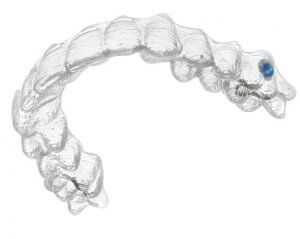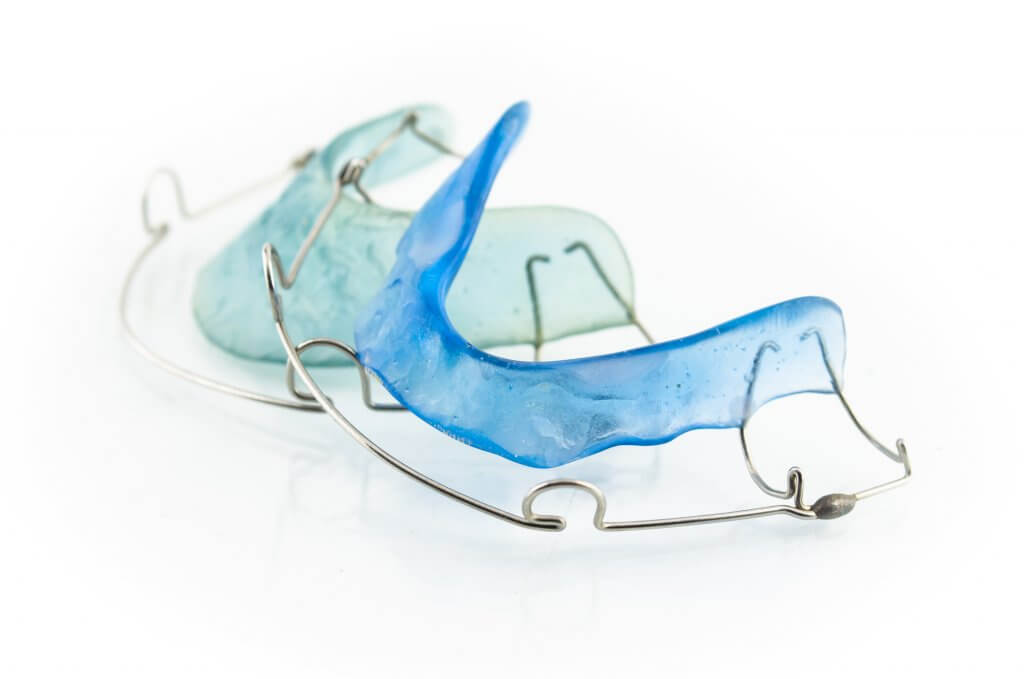There are many types of braces available for treating children’s teeth. These include traditional metal braces as well as more modern styles like Invisalign invisible braces. In this article, we discuss the benefits of orthodontics for kids and explain more about the types of children’s braces available in the US.
Braces for kids cost from $2,000 to $7,500 for traditional metal braces, but many children are eligible for coverage through federally or state-funded children’s insurance programs.
Visit Medicaid.gov to find out more!
You can find more information about your child’s oral health in our full selection of articles on dental care for babies and children.
Before we dive in, do you need help finding an orthodontist for your child? If so, you can call 866-383-0748 and talk to a live operator who will put you in touch with an orthodontist in your area.
At what age can children have orthodontic braces?
Children can have orthodontic braces at any age to straighten teeth, but typically from 10-14 years of age, since they are usually more effective on children whose bones are still growing and forming.


However, some children start treatment as early as age 7 or 8 if there is a medical reason to do so. A lot depends on the type of problem they have and how their adult teeth are coming through.
Early treatment can help:
- Guide growth of the jaw bone
- Move teeth into the correct position as they emerge
- Reduce the risk of injury to prominent teeth
- Make space for teeth coming through
- Lower the chances of teeth becoming impacted under gums
- Improve facial esthetics
But this doesn’t mean that all children need to start treatment early. In some cases it’s better to wait until more adult teeth have come through.
There is no set timeframe for when to take your child in for orthodontic care. In most cases, a child shouldn’t have braces if they haven’t lost most or all of their baby teeth. Every child has their teeth come in at different times, but most begin to lose their baby teeth at the age of 6 and will continue losing them until they are about 12. Putting your child in braces before they have most of their adult teeth could mean multiple rounds of braces and orthodontic work in the future.
Dr. Travis R. Willey, Family & Cosmetic Dentistry of the Rockies
When to visit an orthodontist
You should take your child to the dentist every six months to check their overall oral health as well as the development of their teeth. If the dentist is concerned about your child’s teeth they will refer him or her to an orthodontist – a dentist who specializes in correcting tooth and jaw alignment problems.
Signs that your child may need braces include:


- Losing baby teeth early or late
- Crowded teeth
- Teeth coming through in the wrong position
- Teeth that don’t make contact (open bite)
- Difficulty eating or biting
- They often bite their cheeks
- Thumb sucking or pacifier use past age 6
Many orthodontists recommend that children visit by age 7, when their adult teeth have begun appearing. By this stage, any alignment issues should be apparent and the orthodontist can plan their treatment – even if it won’t begin for another few years. Identifying the need for braces early on means your child can get treatment in the most effective way possible.
But even if your child is in their teens, it’s not too late to begin treatment. If you have any concerns, mention it to their dentist or book an appointment directly with an orthodontist.
Types of braces for kids
The types of braces available for children are much the same as those used for adult orthodontics, although some have special features for kids.


Metal
Traditional metal braces are by far the most common for children and they are also usually the cheapest option available.
A bracket is affixed to each tooth and a metal wire joins them all together. By tightening the wire in certain places with regular adjustments, the dentist gradually manipulates teeth into position.
As a parent, you may remember metal braces being enormous and uncomfortable to wear. Fortunately, technology has been advancing over the past 25 years or so, and brace brackets are much smaller and neater than before.
They also carry an element of fun for kids as they can customize them with different braces colors.
Metal braces offer effective teeth straightening for all kinds of alignment problems, with treatment usually taking 18-24 months.
Children will need special help cleaning their braces and teeth because it’s easy for food and bacteria to get stuck in the brackets. A children’s electric toothbrush with a special orthodontic head can make this process easier.
Braces can cause discomfort and some pain due to the teeth adjusting and brackets poking the mouth, but this can be alleviated with over-the-counter painkillers and products like dental wax. Read more about how to use dental wax.
In the following video you can view the process of fitting braces for a young patient’s journey:
Ceramic (clear and tooth-colored)
These braces function in much the same way as metal ones, but the materials used make them less noticeable. The ceramic clear brackets come in a clear or tooth-colored material so they blend in better with the teeth. The wire is still usually metal, although it can have a tooth-colored coating.
The materials used in these braces means they usually cost more than metal, but they could be a good choice for children who are feeling very self-conscious about their orthodontic treatment.
Lingual (Incognito)
Lingual braces use metal brackets and wires but are tucked out of sight behind the teeth, next to the tongue. This positioning makes it very hard to spot them, so they are another good choice for children who are afraid of being bullied because of their braces.
Another benefit is that any staining which occurs as a result of poor oral hygiene will be hidden on the back of the teeth.
However, treatment with lingual braces typically takes longer than with those attached to the front of teeth. They are also generally the most expensive option, and aren’t suitable for children with particularly small teeth.
Invisalign Teen
Despite the name, Invisalign Teen can actually be used by children as young as 11, provided they have lost all their baby teeth. This system offers a completely different way to straighten teeth. Instead of having fixed brackets, a series of clear, removable aligners guide teeth into position.


This system has some clear advantages for children:
- The aligners are very hard to notice, giving them the name “invisible braces”
- They can be removed for 2-4 hours a day
- Wearers can clean their teeth as normal
- The design allows for new teeth to come through
- A wear indicator on each aligner shows if they are being worn enough
But of course there are some potential downsides, too. Compliance may be an issue, even with the wear indicator, so parents will have to assess whether they think their child has the willpower to wear their aligners as directed.
There is also the issue of eating. You must remove the aligners to eat and drink anything except water, and you have to clean the aligners and your teeth before replacing them. Failure to do this may stain the aligners and teeth, and increase chances of tooth decay.
Invisalign Teen is a great solution for children who are conscious of their appearance. Treatment can be as effective as metal braces, without the risk of teasing. You’ll just need to explain the importance of wearing the aligners all day and cleaning them after eating.
At-home clear aligners
At-home aligners are similar to Invisalign in that they are clear and removable, but they generally have a lower cost due to not requiring in-office visits with your dentist.
This type of clear aligner treatment can be performed completely remotely if wanted but they are not to be confused with fake DIY braces that are becoming more popular. Some brands have physical locations where a specially trained representative can help you take digital dental scans and answer in-person any questions you may have.
Additionally, they won’t have to miss any school to go to dentist appointments! Keep in mind, however, that at-home clear aligners can’t correct jaw alignment problems or severely crooked teeth.
Wearing a retainer
All these different types of braces have one job: to move teeth into a new position. But the purpose of a teeth retainer is the exact opposite: to stop teeth from moving once treatment is complete.


Your child will probably have to wear a retainer every night at first, and possibly during the day. If they stop wearing it, there is a good chance their teeth will start to move out of alignment again. Many adults who had braces as a child must continue wearing a retainer for the rest of their lives – at least on a part-time basis – if they want their teeth to stay straight.
There are two main types of removable retainer. One looks much like an Invisalign aligner or mouthguard. The other has an acrylic base and wires that clip around the teeth. Your child will need to take good care of their retainer and keep their retainer clean, as replacements can cost $150 or more. Learn how to clean retainers.
Another way to keep teeth straight is with a fixed retainer. This is just a small wire fixed to the back of the front few teeth to stop them from moving. Ask your dentist about the retainer options for your child after braces.
How much do braces cost for kids?
Braces for kids cost anywhere from $2,000 to $7,500 for traditional metal braces. Prices can go higher for specialty braces like ceramic or for invisible braces.
Children’s braces are usually a little cheaper than adults’ braces, simply because less material is required to reach all of their teeth. However, the number of appointments and the amount of time spent in the dentist’s chair remain much the same, so there is not a huge difference in cost between the different age groups.
Is your child eligible for braces in the US?
States are required to provide medically necessary orthodontic services to American children (under age 21) who are covered by Medicaid and the Children’s Health Insurance Program (CHIP).
Medical necessity is determined by each state, and is validated at an oral screening where a dentist will assess your child’s teeth to determine whether teeth straightening would be of benefit medically, or purely cosmetically.
You can learn more about dental coverage in your state, and find participating Medicaid and CHIP dental providers and benefit packages in your area by visiting InsureKidsNow.gov. Read more about the best dental insurance for families and orthodontics.
If you and your child are not eligible for Medicaid, you will have to cover the costs of your child’s braces.
Self-funding your children’s braces
The cost of braces for your child will depend on a number of factors, including the style you choose and the length and complexity of the treatment required.
The table below gives an idea of what different types of braces for kids cost if both the upper and lower arch need treatment. You’ll need to have a consultation to get a personalized quote for your child.
| Type | Approximate cost (US) |
| Metal | $2,500 – $7,000 |
| Ceramic | $3,500 – $8,000 |
| Lingual | $4,000 – $13,000 |
| Invisalign Teen | $3,000 – $6,500 |
| At-home clear aligners, e.g. Candid | Around $2,000 |
If these costs seem a little overwhelming, ask about dental payment plans. Many dental clinics have ways for you to spread the cost of treatment, often with 0% interest.
And if you have dental insurance for your child, it’s worth checking whether your policy will make a contribution towards your kids’ braces costs.
Some dental insurance plans in the US provide dental coverage for children, provided the treatment is deemed medically necessary. Even so, most plans only reimburse around 25% of costs – 50% at most – so out-of-pocket costs typically reach thousands of dollars.
How to find a children’s orthodontist
Although any orthodontist can fit braces for children, you may prefer to use one who has experience with younger patients. It’s important your child feels comfortable with their orthodontist so they can ask questions freely and don’t come to dread visits.
The easiest way to find an orthodontist for your child is by calling 866-383-0748. You’ll be connected to a live operator who will put you through to licensed practitioners in your area.
Another way is to ask around other parents in your area. Chances are many of them – especially those with older kids – will have some experiences to share.
The location of the dentist is also important. Whichever style of braces you choose, you’ll need to go for regular checkups and adjustments. For minimal disruption to your workday and your child’s school day, choose a dentist close to you.
Finally, consider the cost. As mentioned above, some dental clinics have higher prices than others. Some offer special rates for certain types of kids’ braces while others don’t. Shop around a few places if you want to find the best deal on your child’s braces.
Conclusion
It’s relatively common for children to get braces to straighten their teeth, but as a parent there are many decisions you must make regarding their treatment. The first step is to speak to a dentist or orthodontist to determine whether your child needs orthodontic work.


If your child qualifies for treatment under Medicaid and CHIP, and your state covers orthodontic services, they will get the kind of braces determined medically necessary by the state. If you are paying for braces yourself, you will have more freedom to choose from different options, some of which are much less conspicuous.
You’ll need to help your child clean their teeth well while they are wearing braces. There may also be certain foods they have to avoid. Once treatment is complete, they might need a gentle reminder to wear their retainer as directed. But all this hard work will pay off when they have a straighter smile they feel confident with!
FAQs
What age should kids get braces?
Kids should get braces anywhere from 10 to 14 years old, give or take a couple of years — it all depends on the individual. Many orthodontists recommend that children visit by age 7. At this point, adult teeth have begun appearing and the orthodontist will be able to tell if your kid will need treatment.
Kids should generally wait to get braces until all of their permanent teeth have come in, but and orthodontist will be able to tell you the exact right timing.
How much do braces for kids cost?
Without insurance, your child’s braces will cost anywhere between $2,500 and $7,000. Your child may be eligible for CHIP or Medicaid, in which case, braces could be covered by insurance.
Can kids get Invisalign?
Children as young as 11 years old are eligible for Invisalign Teen, as long as they’ve lost all their baby teeth. Invisalign Teen is specially developed for kids and teens. It has an indicator that lets parents and doctors know if the patient complies with treatment.




